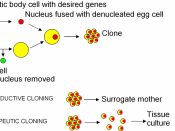The first thing that must be cleared up is what is cloning, and what is a clone. A clone is an organism derived asexually from a single individual by cuttings, bulbs, tubers, fission, or parthenogenesis reproduction ("Cloning", 1997). Pathogenesis reproduction is the development of an organism from an unfertilized ovum, seed or spore ("Pathogenesis", 1997). So cloning, biologically speaking, is any process in which production of a clone is successful. Therefore, the biological term cloning is the production of a genetically identical duplicate of an organism. However, people can use the word cloning to intend other meanings. For instance, we generalize many older and new techniques as cloning. This is not a good practice because these techniques are different and impose unique concerns and issues. In the world of scientific technology, cloning is the artificial production of organisms with the same genetic material. Scientists actually call the transferring of a nucleus from the cell of one organism to an enucleated egg cell, nuclear transfer (Wilmut 811).
This will produce an organism that has the exact genetic material as that of the donor cell. Scientists are using current techniques exceedingly more, and with a variety of species. Astonishingly, more clones are present in the world than one would think. In nature, and even in the lives of humans, clones are present. As stated earlier, a clone is an organism that has the same genetic information as another organism. From this we can say that cloning occurs with all plants, some insects, algae, unicellular organisms that conduct mitosis or binary fission, and occasionally by all multi-cellular organisms, including humans. Monozygotic twins, or identical twins, are clones of each other. They have the same exact genetic information due to the division of an embryo early in development, which produces two identical embryos. About...


